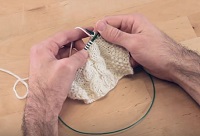Continental knitting is a term used to describe knitters that hold their
 Continental knitting is a term used to describe knitters that hold their working yarn in the left hand while knitting. Eastern (American) knitters hold the working yarn in the right hand. Which method you learn is probably based on which version your instructor is using. Stitch formation and pattern instructions are exactly the same for both methods.
Continental knitting is a term used to describe knitters that hold their working yarn in the left hand while knitting. Eastern (American) knitters hold the working yarn in the right hand. Which method you learn is probably based on which version your instructor is using. Stitch formation and pattern instructions are exactly the same for both methods.With the yarn in the left hand, Continental knitters need to take more care that the newly formed stitch on the right needle does not pull off as tension is applied to the yarn to form a new stitch. Holding the yarn in the right hand, gives Eastern knitters an advantage. With the new stitch going on the right needle and the tension pulling to the right, natural forces help keep the last new stitch in place.
Each of these two methods can also be divided into two groups. Those that pick the yarn with the needle tip and those that throw the yarn. Both groups can choose the direction of the wrap as long as the direction of the working yarn is properly paired or twisted sitches can result. The result is a wide variation of ways to knit.
Continental knitters that pick the yarn are indeed fast when they knit and is a great technique for circular knitting. However, Continental purling requires a double wrap, so speed is greatly reduced on the purl rows. The change from a single pick for a knit stitch to the double picking required for a purl stitch make it more difficult to achieve equal tension on all rows for Continental knitters.
Eastern knitters maintain much the same wrap pattern on both knit and purl rows, speed of knitting is more constant. This seems to result in a more even tension on knit and purl rows especially for new knitters.
Neither method is more right or wrong. Several years ago, the fastest knitter in the world was an Eastern style knitter. Having a great support system and producing an attractive even fabric with little or no frustration is the ultimate goal.
The picture above was taken from a KnitPicks video titled Cabling without a Cable Needle. While this short video is about something else, it does also show clearly how to knit stitches using the Continental method.

